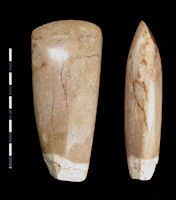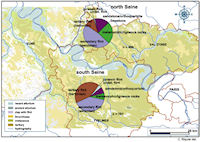
Figure 13: Exogeneous Jurassic flint axes from lower Normandy found near the Seine valley and tertiary flint found in the Caen-Alençon area (DAO C. Riquier/F. Giligny)
Other materials are exogeneous. Axes made of Jurassic flint originate from Normandy, at the fringes of the Armorican Massif, where flint mines are known in the Caen-Falaise plain, more than 150km away (Desloges 1986; 1999; Fig. 13). These are always polished axes. Tertiary flint axes are also present to the west, and originated from the Tertiary basin, probably in the Seine valley, which suggests a two-way circulation.

Figure 13: Exogeneous Jurassic flint axes from lower Normandy found near the Seine valley and tertiary flint found in the Caen-Alençon area (DAO C. Riquier/F. Giligny)
The presence of axes manufactured from non-local igneous and metamorphic rocks suggests that some axes came into the study area from the Armorican massif and the Alps (Fig. 14). Others may come from Vosges, the Central Massif or the Ardennes. The Seine valley may be viewed as an important centre both for distribution and exchange, perhaps serving as a geographical distribution centre for Armorican and Alpine axes.
Mapping the distribution of polished axes, both finished and roughout axes, has been carried out to discover regional patterns and characteristics. This analysis is based on examination of more than 3000 axes. Most of them are surface finds, but some, which have more secure archaeological contexts and can be dated, will provide a valuable chronological framework. One can, however, observe a difference in the density of axe finds from regions situated to the south and the north of the Seine (Fig. 15). The quantity of polished axes manufactured using Tertiary flint is particularly low in the Vexin (16%), which suggests that the Seine could have been a major natural barrier. The existence of axe manufacturing workshops using secondary flint, in both regions, could also provide an explanation. South of the Seine in the Mantois region, the two types of raw material are found in equal proportions. Sandstone and imported rocks have their highest frequency to the north.

Figure 15: Nature of material used for polished axes to the North and South of the Seine. (DAO C. Riquier/F. Giligny).
It remains to be seen to what extent these regionally organised territories associated with mining complexes played a role in the distribution of domestic tools, and how this related to the circulation of such prestige items as Alpine jadeite axes, for example (Giligny in press). Some local axes are probably prestige items, which may have been objects of social competition between individuals and communities.
© Internet Archaeology/Author(s) URL: http://intarch.ac.uk/journal/issue26/12/3.html
Last updated: Wed Jul 1 2009